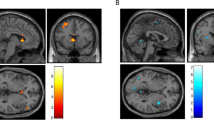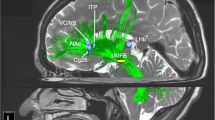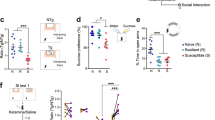Abstract
Dopamine (DA) neurotransmission is critical for motivational processing. We assessed whether disruption of DA synthesis in healthy controls using an amino-acid beverage devoid of catecholamine precursors (tyrosine–phenylalanine depletion (TPD)) would blunt recruitment of the nucleus accumbens (NAcc) by rewards. Sixteen controls ingested each of a tyr/phe-depleting beverage (DEP) or a tyr/phe-balanced (BAL) control beverage in two laboratory visits. Five hours after consumption of each drink, subjects underwent functional magnetic resonance imaging while they viewed anticipatory cues to respond to a target to either win money or avoid losing money. TPD did not exert main effects on mood or on task behavior, but affected brain activation. In right NAcc, TPD blunted activation by anticipation of high rewards. In left NAcc, recruitment anticipating high rewards was modulated by individual differences in mood change across the DEP drink day, where subjects whose mood worsened following TPD (relative to within-day mood change under BAL conditions) also showed lower activation under DEP conditions relative to BAL conditions. Exploratory analysis indicated that TPD qualitatively blunted the voxel-wise spatial extent of suprathreshold activation by reward anticipation. Finally, loss outcomes activated anterior insula under DEP conditions but not under BAL conditions. These data indicate that: (1) dietary depletion of catacholamine precursors will blunt dopaminergic mesolimbic activity, and (2) in controls, synthetic pathways of this neurocircuitry maintain sufficient buffering capacity to resist an effect on motivated behavior. Additional studies are needed to determine if clinical populations would show similar resistance to behavioral effects of TPD.
Similar content being viewed by others
Log in or create a free account to read this content
Gain free access to this article, as well as selected content from this journal and more on nature.com
or
References
Biggio G, Porceddu ML, Gessa GL (1976). Decrease of homovanillic, dihydroxyphenylacetic acid and cyclic-adenosine-3′,5′-monophosphate content in the rat caudate nucleus induced by the acute administration of an aminoacid mixture lacking tyrosine and phenylalanine. J Neurochem 26: 1253–1255.
Bjork JM, Knutson B, Fong GW, Caggiano DM, Bennett SM, Hommer DW (2004). Incentive-elicited brain activation in adolescents: similarities and differences from young adults. J Neurosci 24: 1793–1802.
Bjork JM, Smith AR, Hommer DW (2008). Striatal sensitivity to reward deliveries and omissions in substance dependent patients. NeuroImage 42: 1609–1621.
Blum K, Braverman ER, Holder JM, Lubar JF, Monastra VJ, Miller D et al (2000). Reward deficiency syndrome: a biogenetic model for the diagnosis and treatment of impulsive, addictive, and compulsive behaviors. J Psychoactive Drugs 32 (Suppl i–iv): 1–112.
Buckholtz JW, Treadway MT, Cowan RL, Woodward ND, Benning SD, Li R et al (2010). Mesolimbic dopamine reward system hypersensitivity in individuals with psychopathic traits. Nat Neurosci 13: 419–421.
Coupland N, Zedkova L, Sanghera G, Leyton M, Le Melledo JM (2001). Response to pentagastrin after acute phenylalanine and tyrosine depletion in healthy men: a pilot study. J Psychiatry Neurosci 26: 247–251.
da Silva Alves F, Schmitz N, Figee M, Abeling N, Hasler G, van der Meer J et al (2011). Dopaminergic modulation of the human reward system: a placebo-controlled dopamine depletion fMRI study. J Psychopharmacol 25: 538–549.
Dichter GS, Kozink RV, McClernon FJ, Smoski MJ (2012). Remitted major depression is characterized by reward network hyperactivation during reward anticipation and hypoactivation during reward outcomes. J Affect Disord 136: 1126–1134.
Ernst T, Yakupov R, Nakama H, Crocket G, Cole M, Watters M et al (2009). Declined neural efficiency in cognitively stable human immunodeficiency virus patients. Ann Neurol 65: 316–325.
Haber SN, Knutson B (2010). The reward circuit: linking primate anatomy and human imaging. Neuropsychopharmacology 35: 4–26.
Harmer CJ, McTavish SF, Clark L, Goodwin GM, Cowen PJ (2001). Tyrosine depletion attenuates dopamine function in healthy volunteers. Psychopharmacology (Berl) 154: 105–111.
Harper AE, Benevenga NJ, Wohlhueter RM (1970). Effects of ingestion of disproportionate amounts of amino acids. Physiol Rev 50: 428–558.
Hasler G, Luckenbaugh DA, Snow J, Meyers N, Waldeck T, Geraci M et al (2009). Reward processing after catecholamine depletion in unmedicated, remitted subjects with major depressive disorder. Biol Psychiatry 66: 201–205.
Hernandez G, Haines E, Rajabi H, Stewart J, Arvanitogiannis A, Shizgal P (2007). Predictable and unpredictable rewards produce similar changes in dopamine tone. Behav Neurosci 121: 887–895.
Knutson B, Adams CM, Fong GW, Hommer D (2001). Anticipation of increasing monetary reward selectively recruits nucleus accumbens. J Neurosci 21: RC159.
Knutson B, Delgado MR, Phillips PEM (2009). Representation of subjective value in the striatum. In: Glimcher PW, Camerer CF, Fehr E, Poldrack RA, (eds). Neuroeconomics: Decision-Making and the Brain. Elsevier: New York, NY. pp 389–406.
Leyton M, Young SN, Blier P, Baker GB, Pihl RO, Benkelfat C (2000). Acute tyrosine depletion and alcohol ingestion in healthy women. Alcohol Clin Exp Res 24: 459–464.
Lythe KE, Anderson IM, Deakin JF, Elliott R, Strickland PL (2005). Lack of behavioural effects after acute tyrosine depletion in healthy volunteers. J Psychopharmacol 19: 5–11.
McNair DM, Lorr M, Droppleman LF (1992) Profile of Mood States. Educational and Industrial Testing Service San Diego, CA.
McTavish SF, Callado L, Cowen PJ, Sharp T (1999a). Comparison of the effects of alpha-methyl-p-tyrosine and a tyrosine- free amino acid load on extracellular noradrenaline in the rat hippocampus in vivo. J Psychopharmacol 13: 379–384.
McTavish SF, Cowen PJ, Sharp T (1999b). Effect of a tyrosine-free amino acid mixture on regional brain catecholamine synthesis and release. Psychopharmacology (Berl) 141: 182–188.
McTavish SF, Mannie ZN, Cowen PJ (2004). Tyrosine depletion does not cause depressive relapse in antidepressant-treated patients. Psychopharmacology (Berl) 175: 124–126.
McTavish SF, Mannie ZN, Harmer CJ, Cowen PJ (2005). Lack of effect of tyrosine depletion on mood in recovered depressed women. Neuropsychopharmacology 30: 786–791.
McTavish SF, McPherson MH, Sharp T, Cowen PJ (1999c). Attenuation of some subjective effects of amphetamine following tyrosine depletion. J Psychopharmacol 13: 144–147.
McTavish SF, Raumann B, Cowen PJ, Sharp T (2001). Tyrosine depletion attenuates the behavioural stimulant effects of amphetamine and cocaine in rats. Eur J Pharmacol 424: 115–119.
Milner JD, Wurtman RJ (1986). Catecholamine synthesis: physiological coupling to precursor supply. Biochem Pharmacol 35: 875–881.
Moja EA, Lucini V, Benedetti F, Lucca A (1996). Decrease in plasma phenylalanine and tyrosine after phenylalanine–tyrosine free amino acid solutions in man. Life Sci 58: 2389–2395.
Nagano-Saito A, Cisek P, Perna AS, Shirdel FZ, Benkelfat C, Leyton M et al (2012). From anticipation to action, the role of dopamine in perceptual decision making: an fMRI-tyrosine depletion study. J Neurophysiol 108: 501–512.
Oldendorf WH (1973). Stereospecificity of blood-brain barrier permeability to amino acids. Am J Physiol 224: 967–969.
Palmour RM, Ervin FR, Baker GB, Young SN (1998). An amino acid mixture deficient in phenylalanine and tyrosine reduces cerebrospinal fluid catecholamine metabolites and alcohol consumption in vervet monkeys. Psychopharmacology (Berl) 136: 1–7.
Schott BH, Minuzzi L, Krebs RM, Elmenhorst D, Lang M, Winz OH et al (2008). Mesolimbic functional magnetic resonance imaging activations during reward anticipation correlate with reward-related ventral striatal dopamine release. J Neurosci 28: 14311–14319.
Schultz W (2007). Behavioral dopamine signals. Trends Neurosci 30: 203–210.
Silverstone T (1983). The clinical pharmacology of appetite—its relevance to psychiatry. Psychol Med 13: 251–253.
Stein DJ (2008). Depression, anhedonia, and psychomotor symptoms: the role of dopaminergic neurocircuitry. CNS Spectr 13: 561–565.
Stoy M, Schlagenhauf F, Sterzer P, Bermpohl F, Hagele C, Suchotzki K et al (2012). Hyporeactivity of ventral striatum towards incentive stimuli in unmedicated depressed patients normalizes after treatment with escitalopram. J Psychopharmacol 26: 677–688.
Stuber GD, Klanker M, de Ridder B, Bowers MS, Joosten RN, Feenstra MG et al (2008). Reward-predictive cues enhance excitatory synaptic strength onto midbrain dopamine neurons. Science 321: 1690–1692.
Tam SY, Roth RH (1997). Mesoprefrontal dopaminergic neurons: can tyrosine availability influence their functions? Biochem Pharmacol 53: 441–453.
van Ruitenbeek P, Sambeth A, Vermeeren A, Young SN, Riedel WJ (2009). Effects of L-histidine depletion and L-tyrosine/L-phenylalanine depletion on sensory and motor processes in healthy volunteers. Br J Pharmacol 157: 92–103.
Wilkinson D, Halligan P (2004). The relevance of behavioural measures for functional-imaging studies of cognition. Nat Rev Neurosci 5: 67–73.
Acknowledgements
This paper is dedicated to the memory of Dr Daniel W Hommer. We thank Ashley R Smith for her dutiful subject recruitment and data collection, and Erick Singley for the plasma amino-acid analysis.
Author information
Authors and Affiliations
Corresponding author
Additional information
Supplementary Information accompanies the paper on the Neuropsychopharmacology website
Supplementary information
Rights and permissions
About this article
Cite this article
Bjork, J., Grant, S., Chen, G. et al. Dietary Tyrosine/Phenylalanine Depletion Effects on Behavioral and Brain Signatures of Human Motivational Processing. Neuropsychopharmacol 39, 595–604 (2014). https://doi.org/10.1038/npp.2013.232
Received:
Revised:
Accepted:
Published:
Issue date:
DOI: https://doi.org/10.1038/npp.2013.232
Keywords
This article is cited by
-
Acute depletion of dopamine precursors in the human brain: effects on functional connectivity and alcohol attentional bias
Neuropsychopharmacology (2021)
-
No effect of a dopaminergic modulation fMRI task by amisulpride and L-DOPA on reward anticipation in healthy volunteers
Psychopharmacology (2021)
-
Neuroscience of apathy and anhedonia: a transdiagnostic approach
Nature Reviews Neuroscience (2018)
-
Inflammation Effects on Motivation and Motor Activity: Role of Dopamine
Neuropsychopharmacology (2017)
-
Dopamine Depletion Reduces Food-Related Reward Activity Independent of BMI
Neuropsychopharmacology (2016)



